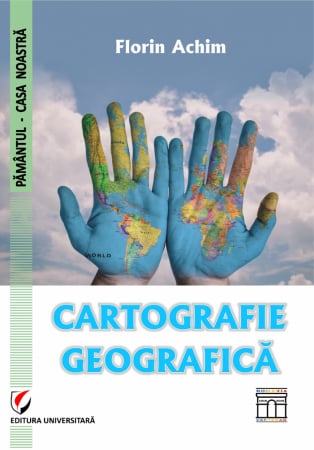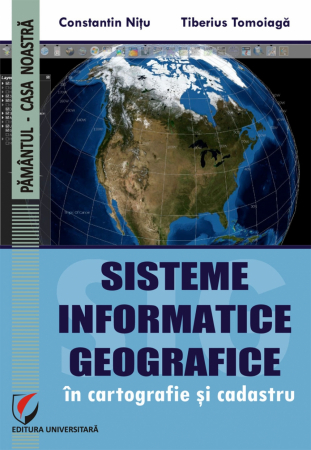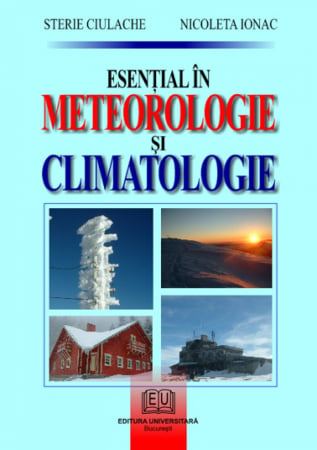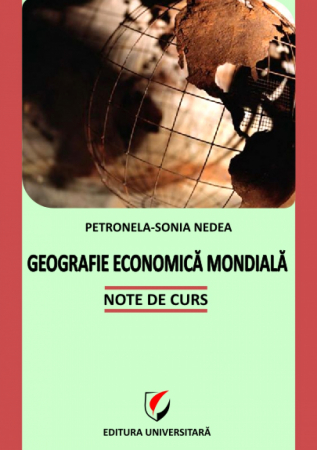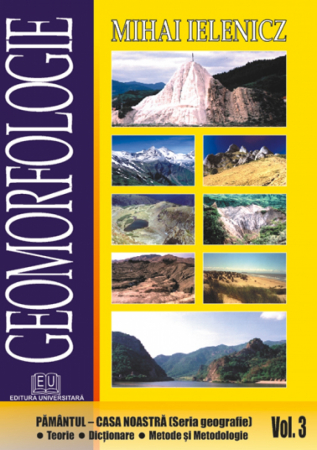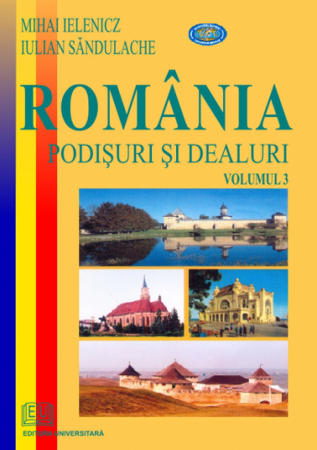Manuscript proposals: [email protected] / 0745 204 115 //// Tracking orders Individuals / Sales: 0745 200 357 / Orders Legal entities: 0721 722 783
ISBN: 978-973-749-190-9
Publisher year: 2007
Edition: I
Pages: 300
Publisher: Editura Universitară
Author: Mihai Ielenicz
Product Code:
9789737491909
Do you need help?
0745 200 357
- Description
- Download (1)
- Authors
- Content
- More details
- Reviews (0)
This book seeks to present, in a synthesis determined by the main destination, the main problems required by the knowledge of several distinct components - climate, water, living things, soils - viewed in systemic interdependence. In this way, although they follow one another in a natural order to the classical geographical approach, the multitude of genetic-evolutionary explanations ensures the connection not only at the chapter level but of the whole work. From the multitude of general and particular aspects, we stopped at those with distinct significance at the level of each environmental component, and within them at a hierarchical staggering and treatment according to their importance in the system. At the same time, we went from an overall analysis (in Romania) to regional and local situations with as many examples as possible through text, maps, diagrams or reflected in photographs.
-
Romania. Physical Geography. vol. II, Climate, Water, Vegetation, Soils, Environment
Download
Prof. univ. dr., graduated from the Faculty of Geology-Geography in 1964 where he continued his activity going through all the steps of the university hierarchy. Doctor in Geography since 1978 with the work "Mountains from the Buzau basin - study of geomorphology", published in the Academy Publishing House in 1984. He won the Academy Award in 1975 for the work "Relief of Romania" and in 1985 for the work "Encyclopedia of Romania", as well as the title of Doctor Honoris Causa of Stefan cel Mare University - Suceava; he has been awarded over 25 honorary diplomas, excellence and medals by various teaching and scientific institutions in the country and abroad. Vice-Dean and Dean of the Faculty of Geography since 1992 and until now, Director of the Geographical Resort Orsova, Co-director of the "Center for Research on Land Degradation and Geomorphological Dynamics" Member of the Faculty Council and the University Senate since 1992, Chairman of the Committee National Program for Pre-University Education (since 1996), CNATDC member, CNEAA, CNCSIS expert, training in the country and abroad (Great Britain, Belgium, Turkey), President of the Geography School Olympics (since 1996), President of the Geography Society since 2003), Vice President of the National Geography Committee (since 2000), Vice President of the Geomorphology Association (since 2002), PhD supervisor (since 1993), member of the editorial boards of numerous specialized journals, etc. He wrote alone and in collaboration over 210 scientific papers, participated in 62 research contracts (18 as director), 38 scientific books: "General Geomorphology" 1976, 2002, "Relief of Romania" 1975, "Hills and Plateau of Romania ”1999,„ Dictionar fizico-geografic ”1999,„ Geografia generala ”2001,„ Romania Geography and Tourism ”2001,„ Europa Enciclopedie Geografica ”2002,„ Subcarpatii Romaniei ”2003,„ Romania - Geografie Fizica ”2004,“ Geografie fizica generala . The bases of physical geography ”2005“ Subcarpathians of Romania ”2005,“ Geomorphology ”2007, 2010,“ Romania. Physical geography. Climate, Waters, Vegetation, Soils ”2007,“ Romania. Plateau and hills ”2008,“ Dictionary of geomorphology ”2009,“ General physical geography with elements of cosmology ”2009,“ Romania - Tourist potential ”2009, and numerous popularization books, maps, etc.
Argument / 5
CHAPTER I. CLIMATE / 7
1. Current climate - the result of a long evolution / 7
1.1. General elements / 7
1.2. Climate evolution on the Globe and in Romania / 8
2. Romania in the space of some European climatic interferences / 14
2.1. Genetic factors of Romania 's climate / 15
2.1.1. Solar radiation / 15
2.1.2. Air mass dynamics / 18
2.1.3. The influence of the components of the geographical system on the characteristics of the climate / 21
3. Elements that define the climate of Romania / 23
3.1. Thermal regime / 23
3.1.1. Average annual temperatures / 23
3.1.2. January average temperatures. / 25
3.1.3. Average temperatures in July / 27
3.1.4. Seasonal variation of temperatures / 28
3.1.5. Extreme temperatures and thermal amplitudes / 32
3.1.6. Days with characteristic temperatures / 33
3.1.7. Soil thermal regime / 35
3.2. Relative air humidity characteristics / 37
3.3. Nebulae and specific types of days / 38
3.4. Precipitation regime / 39
3.4.1. Average annual rainfall / 40
3.4.2. Average rainfall amounts per season / 42
3.4.3. Maximum rainfall in 24 hours. Torrential rains / 46
3.4.4. Snow and snow cover / 47
3.5. Wind potential / 49
3.5.1. Annual average direction / 49
3.5.2. Average annual wind speed / 51
3.6. Meteorological phenomena / 53
4. Climate reporting to various components of the geographical environment / 55
4.1. Climate and relief of Romania / 55
4.2. Climate and waters / 56
4.3. Climate and vegetation / 57
4.4. Climate and anthropogenic activities / 57
4.4.1. Location and development of settlements and various constructions / 57
4.4.2. Wind and solar radiation, energy sources / 58
4.4.3. Climate and agriculture / 58
4.5. Climate and tourist activities / 60
4.5.1. The effects of climatic conditions on the body / 60
4.5.2. Climatic conditions and tourist activities / 64
4.5.3. Design and realization of constructions and arrangements for tourism. / 65
4.6. The influence of anthropic activities on the evolution of climatic elements / 65
5. Regional climate differences / 67
5.1. The region with temperate oceanic climate / 69
5.2. The region with continental temperate climate / 70
5.3. Mountainous climatic region (Carpathian) / 74
Dictionary / 77
CHAPTER II. APELE / 79
1. General characteristics / 79
2. Hydrographic system formation / 80
2.1. Hydrographic network formation / 80
2.2. Realization of the lake system / 82
2.3. Groundwater system / 83
2.4. Black Sea and relations with the coastal space / 83
3. Groundwater and springs / 85
3.1. Groundwater / 85
3.1.1. Regional differentiations of groundwater / 86
3.2. Izvoarele / 91
4. Surface waters / 97
4.1. Hydrographic network / 97
4.1.1. Defining elements / 97
4.1.2. River supply / 103
4.1.3. River water flow regime / 106
4.1.4. Solid runoff / 122
4.1.5. River water chemistry / 127
4.1.6. Water temperature and frost phenomenon / 128
4.1.7. The Danube - the second river in Europe / 129
4.1.8. Hydrographic systems / 135
4.2. The lakes / 157
4.2.1. General characteristics / 157
4.2.2. The lakes of the Carpathians / 160
4.2.3. Lakes in the regions of hills and plateaus / 161
4.2.4. The lakes in the plain and Dobrogea regions / 167
5. Black Sea / 173
5.1. Continental shore on the Romanian coast / 180
6. Water resources and directions of use / 183
Dictionary / 188
CHAPTER III. VEGETATION AND ANIMALS / 190
1. General characteristics / 190
1.1. Defining elements / 190
1.2. The composition and current biogeographical structure result of the Quaternary evolution / 194
1.3. Retrospective in the biogeographical knowledge of Romania / 195
1.4. Composition and current biogeographic structure. Factors that condition it / 196
2. Biogeographic areas and floors / 197
2.1. Zonal units / 199
2.1.1. Steppe area / 200
2.1.2. Forest-steppe zone / 201
2.1.3. Nemoral zone / 203
2.1.4. European boreal coniferous area / 209
2.2. Vegetation and azonal fauna / 216
2.2.1. Vegetation and fauna along the flowing waters / 216
2.2.2. Aquatic flora and fauna / 217
2.2.6. Vegetation and fauna of swampy and peat lands / 220
2.2.3. Vegetation and fauna from salt lakes and those with thermal and mesothermal waters / 218
2.2.4. Vegetation and fauna of salted lands / 219
2.2.5. Vegetation and fauna of sandy lands / 219
2.2.6. Vegetation and fauna of swampy and peat lands / 220
3. Black Sea creatures (in territorial waters) / 220
4. The vegetal and animal world and the human society / 221
Dictionary / 225
CHAPTER IV. SOILS / 226
1. General characteristics / 226
2. The soils of Romania are predominantly Holocene / 227
3. The history of knowing the edaphic coating / 229
4. Environmental factors and their role in the process the pedogenetics that created the soil system
in our country / 230
5. Classes and types of soil / 234
5.1. Classes and types of zonal and tiered soils / 236
5.1.2. Luvisols (Argiluvisols) / 238
5.1.3. Cambisols / 239
5.1.4. Spodisols (spodosols) / 240
5.1.5. Umbrisols / 241
5.2. Local soils / 241
5.2.1. Hydrisols (hydromorphic soils) / 241
5.2.2. Salsodisols (Halomorphic soils) / 242
5.2.3. Pelisols (Vertisols) / 242
5.2.4. Protisols (Undeveloped, truncated and unclogged soils) / 242
5.2.5. Antrisols / 243
5.2.6. Histosols (organic soils) / 243
6. Regional differences / 243
6.1. Extracarpathian pedo-geographical region / 248
6.2. Intracarpathian pedo-geographical region / 251
6.3. Carpathian pedogeographic region / 252
Dictionary / 254
CHAPTER V. NATURAL GEOGRAPHICAL ENVIRONMENTS / 256
1. Natural geographical environments / 256
2. Direct activities in changing the structure of the natural environment / 257
3. Risks and hazards / 261
3.1. Defining elements / 261
3.2. Types of chance / 262
3.3. Regional differences / 264
4. Types of geographical environments / 265
4.1. Carpathian environment / 265
4.1.1. General characteristics / 265
4.1.2. Subtypes / 266
4.2. The environment of hills and plateaus / 268
4.2.2. Subtypes: / 269
4.3. Environment of lowland and lowland regions / 270
4.3.1. General characteristics / 270
4.3.2. Subtypes: / 270
5. Protection and conservation of the natural environment / 271
Dictionary / 277
BIBLIOGRAPHY / 289
CHAPTER I. CLIMATE / 7
1. Current climate - the result of a long evolution / 7
1.1. General elements / 7
1.2. Climate evolution on the Globe and in Romania / 8
2. Romania in the space of some European climatic interferences / 14
2.1. Genetic factors of Romania 's climate / 15
2.1.1. Solar radiation / 15
2.1.2. Air mass dynamics / 18
2.1.3. The influence of the components of the geographical system on the characteristics of the climate / 21
3. Elements that define the climate of Romania / 23
3.1. Thermal regime / 23
3.1.1. Average annual temperatures / 23
3.1.2. January average temperatures. / 25
3.1.3. Average temperatures in July / 27
3.1.4. Seasonal variation of temperatures / 28
3.1.5. Extreme temperatures and thermal amplitudes / 32
3.1.6. Days with characteristic temperatures / 33
3.1.7. Soil thermal regime / 35
3.2. Relative air humidity characteristics / 37
3.3. Nebulae and specific types of days / 38
3.4. Precipitation regime / 39
3.4.1. Average annual rainfall / 40
3.4.2. Average rainfall amounts per season / 42
3.4.3. Maximum rainfall in 24 hours. Torrential rains / 46
3.4.4. Snow and snow cover / 47
3.5. Wind potential / 49
3.5.1. Annual average direction / 49
3.5.2. Average annual wind speed / 51
3.6. Meteorological phenomena / 53
4. Climate reporting to various components of the geographical environment / 55
4.1. Climate and relief of Romania / 55
4.2. Climate and waters / 56
4.3. Climate and vegetation / 57
4.4. Climate and anthropogenic activities / 57
4.4.1. Location and development of settlements and various constructions / 57
4.4.2. Wind and solar radiation, energy sources / 58
4.4.3. Climate and agriculture / 58
4.5. Climate and tourist activities / 60
4.5.1. The effects of climatic conditions on the body / 60
4.5.2. Climatic conditions and tourist activities / 64
4.5.3. Design and realization of constructions and arrangements for tourism. / 65
4.6. The influence of anthropic activities on the evolution of climatic elements / 65
5. Regional climate differences / 67
5.1. The region with temperate oceanic climate / 69
5.2. The region with continental temperate climate / 70
5.3. Mountainous climatic region (Carpathian) / 74
Dictionary / 77
CHAPTER II. APELE / 79
1. General characteristics / 79
2. Hydrographic system formation / 80
2.1. Hydrographic network formation / 80
2.2. Realization of the lake system / 82
2.3. Groundwater system / 83
2.4. Black Sea and relations with the coastal space / 83
3. Groundwater and springs / 85
3.1. Groundwater / 85
3.1.1. Regional differentiations of groundwater / 86
3.2. Izvoarele / 91
4. Surface waters / 97
4.1. Hydrographic network / 97
4.1.1. Defining elements / 97
4.1.2. River supply / 103
4.1.3. River water flow regime / 106
4.1.4. Solid runoff / 122
4.1.5. River water chemistry / 127
4.1.6. Water temperature and frost phenomenon / 128
4.1.7. The Danube - the second river in Europe / 129
4.1.8. Hydrographic systems / 135
4.2. The lakes / 157
4.2.1. General characteristics / 157
4.2.2. The lakes of the Carpathians / 160
4.2.3. Lakes in the regions of hills and plateaus / 161
4.2.4. The lakes in the plain and Dobrogea regions / 167
5. Black Sea / 173
5.1. Continental shore on the Romanian coast / 180
6. Water resources and directions of use / 183
Dictionary / 188
CHAPTER III. VEGETATION AND ANIMALS / 190
1. General characteristics / 190
1.1. Defining elements / 190
1.2. The composition and current biogeographical structure result of the Quaternary evolution / 194
1.3. Retrospective in the biogeographical knowledge of Romania / 195
1.4. Composition and current biogeographic structure. Factors that condition it / 196
2. Biogeographic areas and floors / 197
2.1. Zonal units / 199
2.1.1. Steppe area / 200
2.1.2. Forest-steppe zone / 201
2.1.3. Nemoral zone / 203
2.1.4. European boreal coniferous area / 209
2.2. Vegetation and azonal fauna / 216
2.2.1. Vegetation and fauna along the flowing waters / 216
2.2.2. Aquatic flora and fauna / 217
2.2.6. Vegetation and fauna of swampy and peat lands / 220
2.2.3. Vegetation and fauna from salt lakes and those with thermal and mesothermal waters / 218
2.2.4. Vegetation and fauna of salted lands / 219
2.2.5. Vegetation and fauna of sandy lands / 219
2.2.6. Vegetation and fauna of swampy and peat lands / 220
3. Black Sea creatures (in territorial waters) / 220
4. The vegetal and animal world and the human society / 221
Dictionary / 225
CHAPTER IV. SOILS / 226
1. General characteristics / 226
2. The soils of Romania are predominantly Holocene / 227
3. The history of knowing the edaphic coating / 229
4. Environmental factors and their role in the process the pedogenetics that created the soil system
in our country / 230
5. Classes and types of soil / 234
5.1. Classes and types of zonal and tiered soils / 236
5.1.2. Luvisols (Argiluvisols) / 238
5.1.3. Cambisols / 239
5.1.4. Spodisols (spodosols) / 240
5.1.5. Umbrisols / 241
5.2. Local soils / 241
5.2.1. Hydrisols (hydromorphic soils) / 241
5.2.2. Salsodisols (Halomorphic soils) / 242
5.2.3. Pelisols (Vertisols) / 242
5.2.4. Protisols (Undeveloped, truncated and unclogged soils) / 242
5.2.5. Antrisols / 243
5.2.6. Histosols (organic soils) / 243
6. Regional differences / 243
6.1. Extracarpathian pedo-geographical region / 248
6.2. Intracarpathian pedo-geographical region / 251
6.3. Carpathian pedogeographic region / 252
Dictionary / 254
CHAPTER V. NATURAL GEOGRAPHICAL ENVIRONMENTS / 256
1. Natural geographical environments / 256
2. Direct activities in changing the structure of the natural environment / 257
3. Risks and hazards / 261
3.1. Defining elements / 261
3.2. Types of chance / 262
3.3. Regional differences / 264
4. Types of geographical environments / 265
4.1. Carpathian environment / 265
4.1.1. General characteristics / 265
4.1.2. Subtypes / 266
4.2. The environment of hills and plateaus / 268
4.2.2. Subtypes: / 269
4.3. Environment of lowland and lowland regions / 270
4.3.1. General characteristics / 270
4.3.2. Subtypes: / 270
5. Protection and conservation of the natural environment / 271
Dictionary / 277
BIBLIOGRAPHY / 289
We set out to make a work in 5-6 volumes that would be useful to students, geography teachers and all those who are directly or indirectly interested in the Romanian geographic system, a system gradually acquired, but whose current "face" belongs especially a sequence of the Quaternary. It is based on a fairly extensive documentation viewed analytically, on a lifetime of work in the field and in the laboratory in the physical environment, and on a continuously integrated systemic conception.
The structure of the paper included two volumes of global analysis on each geographical component, then three with a regional character and one for capitalizing on the natural environment in tourism in the field "in vogue" today but also a personal hobby.
Of these, two books - the extremes - have already been published, and in a short time two more will appear - this volume and the one dedicated to hills and plateaus, which not only occupies most of Romania, but sums up and a complexity of geographical aspects imposed by the interference with the mountain and plain environments and where a significant anthropic pressure was exerted.
This book seeks to present, in a synthesis determined by the main destination, the main problems required by the knowledge of several distinct components - climate, water, living things, soils - viewed in systemic interdependence. In this way, although they follow one another in a natural order to the classical geographical approach, the multitude of genetic-evolutionary explanations ensures the connection not only at the chapter level but of the whole work. From the multitude of general and particular aspects, we stopped at those with distinct significance at the level of each environmental component, and within them at a hierarchical staggering and treatment according to their importance in the system. At the same time, we went from an overall analysis (in Romania) to regional and local situations with as many examples as possible through text, maps, diagrams or reflected in photographs.
The completion of some distinct problems from some chapters materialized in several lines of conclusions, these being necessary for the correlation on wider areas of analysis. At the same time, the interdependence between the elements of the natural environment and the different directions of exercising the more and more active influence of man was not omitted. to be treated succinctly, on the general background of the types of geographical environments and problems hazard-vulnerability-risk, protection and conservation.
The structure of the paper included two volumes of global analysis on each geographical component, then three with a regional character and one for capitalizing on the natural environment in tourism in the field "in vogue" today but also a personal hobby.
Of these, two books - the extremes - have already been published, and in a short time two more will appear - this volume and the one dedicated to hills and plateaus, which not only occupies most of Romania, but sums up and a complexity of geographical aspects imposed by the interference with the mountain and plain environments and where a significant anthropic pressure was exerted.
This book seeks to present, in a synthesis determined by the main destination, the main problems required by the knowledge of several distinct components - climate, water, living things, soils - viewed in systemic interdependence. In this way, although they follow one another in a natural order to the classical geographical approach, the multitude of genetic-evolutionary explanations ensures the connection not only at the chapter level but of the whole work. From the multitude of general and particular aspects, we stopped at those with distinct significance at the level of each environmental component, and within them at a hierarchical staggering and treatment according to their importance in the system. At the same time, we went from an overall analysis (in Romania) to regional and local situations with as many examples as possible through text, maps, diagrams or reflected in photographs.
The completion of some distinct problems from some chapters materialized in several lines of conclusions, these being necessary for the correlation on wider areas of analysis. At the same time, the interdependence between the elements of the natural environment and the different directions of exercising the more and more active influence of man was not omitted. to be treated succinctly, on the general background of the types of geographical environments and problems hazard-vulnerability-risk, protection and conservation.
If you want to express your opinion about this product you can add a review.
write a review

6359.png)
![Romania. Physical Geography. vol.II, climate, water, vegetation, soils, environment [1] Romania. Physical Geography. vol.II, climate, water, vegetation, soils, environment [1]](https://gomagcdn.ro/domains/editurauniversitara.ro/files/product/large/romania-geografie-fizica-vol-ii-clima-ape-vegetatie-soluri-mediu-2693-992218.jpg)
